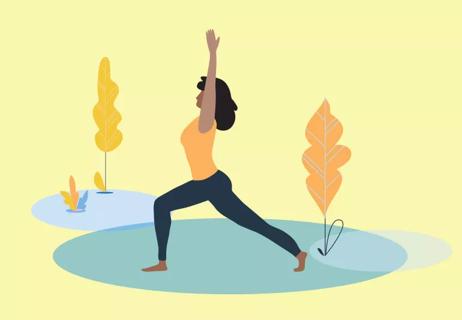This old trick for building habits can work, but you still need motivation, repetition and discipline to get results

It’s true, no matter how spontaneous you are in your daily life: Your brain loves a good routine. The order you put your clothes on, the way you tie your shoes, washing your hands after using the restroom, the route you take on your daily commute — there are a lot of things in life that we can reliably anticipate doing.
Advertisement
Cleveland Clinic is a non-profit academic medical center. Advertising on our site helps support our mission. We do not endorse non-Cleveland Clinic products or services. Policy
“Without anything recognizable, life would be incredibly difficult,” psychologist Lauren Alexander, PhD, notes. “It would provoke tremendous anxiety because there would be no indication of what’s coming next.”
Routine is also important for brain development. Just like building a new skill, developing a new habit requires motivation, repetition and consistency. Whether you’re trying to cook more often, go to bed by 10 p.m. each night or remember your morning medications, you have to practice the habit over and over until it becomes automatic. That’s how the brain builds new synaptic connections. It’s also why we learn new things and adopt habits faster as children, when our brains are still growing and developing and have the greatest neuroplasticity.
You can’t turn back the clock, but you can still develop new habits and behaviors. Habit stacking is one of the many techniques out there that can help. Dr. Alexander explains what it is, how to do it and the factors that will determine your success in creating new habits.
Habit stacking takes advantage of the areas of our lives that are already automatic and reliable. It’s a technique where you attach a new habit to one you already engage in consistently.
Advertisement
“The thinking is that engaging in the already-existing habit will cue you to do your new one,” Dr. Alexander explains. This deliberate rewiring of our brain is called self-directed neuroplasticity.
The term “habit stacking” is new — author James Clear coined it in his bestselling book Atomic Habits: An Easy and Proven Way to Build Good Habits and Break Bad Ones. But the underlying idea has been around for a long time.
Habit stacking can work. But calling the practice “easy” is overstating it. And as we’ll see, there’s no fool-proof technique for building good habits because every ask we make of our brain is a little bit different — and neuroplasticity diminishes as we get older.
Interested in habit stacking, but not sure how to start? Here’s what Dr. Alexander recommends.
Whatever your goal, there’s probably a way you can use habit stacking to encourage it. Here are a few examples of habit stacking to get your wheels turning:
Advertisement
According to Dr. Alexander, it can take anywhere from 18 to 200 days to build a habit. Could habit stacking speed that process up or make it easier?
The less-than-satisfying answer is: Maybe.
Like most self-improvement hacks, habit stacking works well for some people and not for others. Dr. Alexander says success largely depends on the habit itself — both how hard it is and whether it’s something you enjoy doing.
Drinking a glass of water with every meal isn’t particularly difficult or unpleasant. Studying a foreign language or doing yoga for an hour a day, on the other hand, requires much more effort and discipline. Those are tough habits to build under the best of circumstances. And if you don’t enjoy those activities, adding them to your routine will require even more self-control.
“Generally, if people can attach new habits to ones that they already regularly do, they’re going to have some success,” Dr. Alexander notes. “But if the habits that they’re trying to attach to already-existing ones aren’t things they want to do in the first place, that will affect the likelihood of successfully forming the habit.”
Incorporating the Premack principle Dr. Alexander mentioned earlier may up your probability of success in these situations. That’s because having a reward system in place — an immediate reinforcer that follows the habit you’ve stacked — can help with motivation.
Advertisement
If habit stacking hasn’t worked for you, don’t be discouraged. There are lots of ways to train our brains and build good habits! Dr. Alexander recommends you try shaping instead.
“It’s a behavioral principle where you gradually shape your behavior toward a goal,” she explains. This approach can be especially helpful for people with conditions like depression, that impact your ability to self-motivate.
Dr. Alexander offers the example of walking. Let’s say your ultimate goal is walking a mile a day every day. Instead of going from zero to 60, start by putting on your sneakers and doing a lap or two around your apartment. The next day, make it five laps. The next day, do five laps and a turn around the cul-de-sac. Each day, you work your way up to your goal … and build a new habit in the process!
“I recommend shaping a lot because making small changes over time tends to be far less psychologically overwhelming,” she says.
At some point, most of us will try to change our lifestyle in one way or another. And — whether we’re creating good habits or breaking bad ones — we’re likely to struggle a bit. It’s part of the process.
Remember that if you fall short of your goal. There are going to be days when your couch-to-5K running plan feels more like a couch-to-couch plan. But that’s no reason to give up. It’s a reason to make a habit of self-compassion.
Advertisement
Dr. Alexander emphasizes that it’s important to avoid black-and-white thinking. Consistency is key to developing new behaviors, but forgetting or skipping your habit doesn’t mean you’ve failed. Instead, focus on what you have accomplished and get excited to build on it.
“At least you have something!” she emphasizes. “There’s a small snowball there. And tomorrow, you can go out and roll it into something a little bit bigger.”
Whether you habit stack, employ the Premack principle, shape or try something else altogether, remember to celebrate the little victories. And remember: Every day is a new opportunity to make progress!
Learn more about our editorial process.
Advertisement

This social media productivity hack involves carving out time every morning for self-care

Face-touching is a common habit, but one that can be overcome, like by learning to recognize when you’re doing it and keeping your hands distracted

It may feel impossible, but planning, motivation and goal-setting can make leaving old habits behind doable

Little changes can yield big results

Breathing, exercise, mindfulness and more can help you unwind and step away from your stress

Move a little more, eat a little healthier, sleep a little better and destress a lot

From breath meditation to yoga nidra, all types of meditation aim to help you feel calmer, more relaxed and present

This fruit has clear nutritional benefits — but there’s little evidence it can prevent or treat illness

The best parenting style balances enforcing rules and showing plenty of love

Tips include cutting back on sugar, focusing on exercise and managing stress

It can be harder to let go when you’ve invested time, energy and emotions — but it might be the healthier choice long term